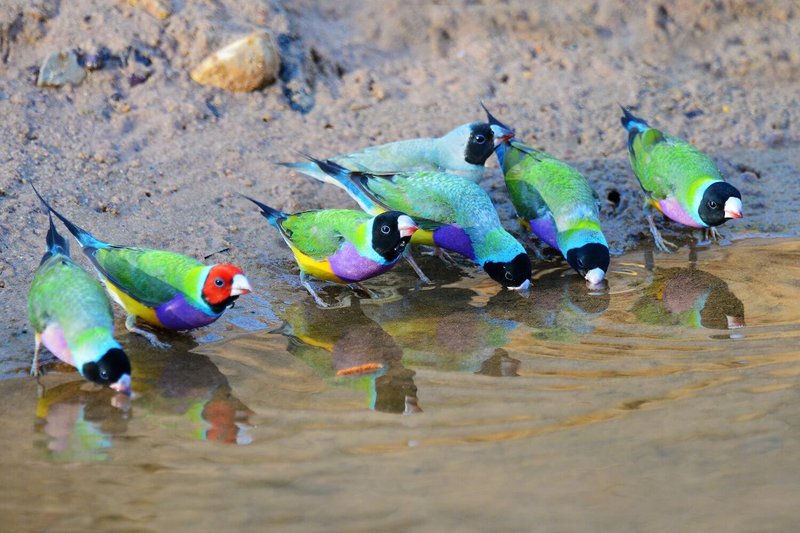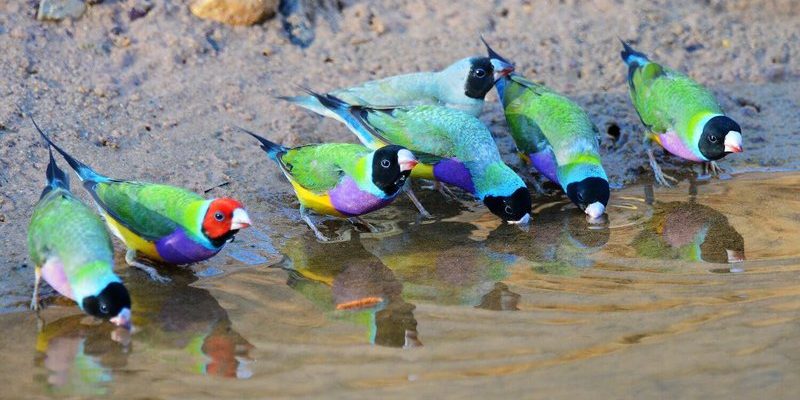
The Gouldian Finch, also known as the *Erythrura gouldiae*, is native to Australia. Understanding where they live is like embarking on a treasure hunt through the lush landscapes of the continent. From the tropical savannas to the woodlands, these birds have specific preferences in habitat that play a crucial role in their survival. So, grab a cup of coffee, and let’s dive into the exciting world of the Gouldian Finch!
Understanding the Gouldian Finch’s Habitat Preferences
The Gouldian Finch thrives in specific environments that provide them with food, water, and shelter. They are commonly found in grasslands, savannas, and open woodlands. Here’s the thing: these birds prefer areas where they can easily find seeds, their primary food source.
In the wild, they can often be spotted around water sources, as they need access to fresh water for drinking and bathing. This means you’ll want to look near billabongs and rivers when trying to catch a glimpse of these beautiful finches. Additionally, they favor areas with trees that provide nesting spots. Think of it as their version of luxury apartments – they need a good view and a steady supply of snacks!
Key Factors Affecting Their Habitat
- Food Availability: An abundance of seeds, particularly from grasses, is crucial.
- Water Sources: Proximity to rivers and ponds is essential for hydration.
- Nesting Opportunities: Trees and shrubs offer safe places for them to raise their young.
Locations in Australia Where You Can Spot Gouldian Finches
Now that we have a grasp on their habitat preferences, let’s narrow down the locations across Australia where you can spot these fantastic birds. Australia is vast and diverse, and the Gouldian Finch can be found in several regions, though they are most commonly associated with the northern parts of the continent.
One of the best places to see them is in Kakadu National Park. This UNESCO World Heritage site offers a rich tapestry of ecosystems, from wetlands to woodlands, making it an ideal spot for Gouldian Finches. You might find yourself standing quietly by the water’s edge, waiting for the flash of color to dart by.
Another great location is the Top End of the Northern Territory, including places like Darwin and the surrounding areas. These regions boast a tropical climate and lush landscapes that support a variety of wildlife, including our colorful friends.
Other Locations to Consider
- The Bungle Bungles in Purnululu National Park
- The Savannah Parks in Queensland
- The Gulf Country regions, especially during the wet season
Seasonal Changes and Their Impact on Visibility
Understanding when to observe Gouldian Finches is just as important as knowing where to find them. These little birds exhibit seasonal behavior changes that can impact your chances of spotting them. Generally, they are more visible during the breeding season, which happens from August to December. During this time, male finches display their vibrant plumage and sing more frequently, making them easier to spot.
However, local conditions play a significant role as well. For example, after a good rainy season, you might notice a higher concentration of finches in particular areas due to the increased availability of food. So, timing your visit after the wet season can provide you with exceptional birdwatching opportunities.
It’s also worth noting that during the hot summer months, you might find them in shaded areas or near water bodies. Here’s a tip: early mornings or late afternoons are usually the best times to look for them, as they are most active during these cooler parts of the day.
How to Spot Gouldian Finches: Tips for Birdwatchers
If you’re eager to add the Gouldian Finch to your birdwatching checklist, you might be wondering how to go about this. Honestly, spotting these birds can be a fun challenge, but it’s definitely doable with some insider tips.
First off, patience is key. Bring your binoculars, find a quiet spot, and let nature work its magic. The Gouldian Finch is known for its lively demeanor but can also be quite shy. Staying still and making minimal noise will increase your chances of seeing them.
Consider joining local birdwatching groups or tours in areas known for their presence. Not only can you learn a lot from experienced birdwatchers, but they often know the best spots to visit and the times to see the finches. Also, having a field guide handy can help you identify them quickly among the many colorful birds you’ll encounter.
Helpful Tips for Spotting Them
- Look for small flocks as they tend to move in groups.
- Listen for their distinctive calls, which can guide you to their location.
- Use apps or websites that track bird sightings to find recent reports.
Conservation Status and Challenges Facing Gouldian Finches
While it’s exciting to think about spotting these colorful birds, it’s crucial to address the conservation challenges they face. The Gouldian Finch is classified as endangered, primarily due to habitat loss, changes in land use, and competition from other bird species. These changes can drastically affect their food supply and nesting opportunities.
Moreover, climate change poses additional threats to their habitat. Increased temperatures and changing weather patterns can impact the availability of seeds and water sources they depend on. Conservation groups are working hard to monitor and protect the Gouldian Finch, focusing on ensuring that their natural habitats remain intact and that they have access to necessary resources.
As a birdwatcher or wildlife enthusiast, being aware of these issues is vital. Supporting conservation efforts, whether through donations, volunteering, or simply spreading awareness, can contribute to the well-being of these beautiful finches.
Final Thoughts on the Gouldian Finch
Spotting a Gouldian Finch is like discovering a hidden gem in the wild – a moment that stays with you long after it happens. By understanding their habitats, knowing where to go, and being aware of conservation efforts, we can appreciate these magnificent birds while helping to ensure their future.
Whether you’re planning a trip to Australia or just daydreaming about these lovely finches, remember that every little step you take can contribute to their preservation. So, the next time you see a colorful finch in a park or nature reserve, take a moment to marvel at its beauty and think of the lush landscapes that make their lives possible. Happy birdwatching!

